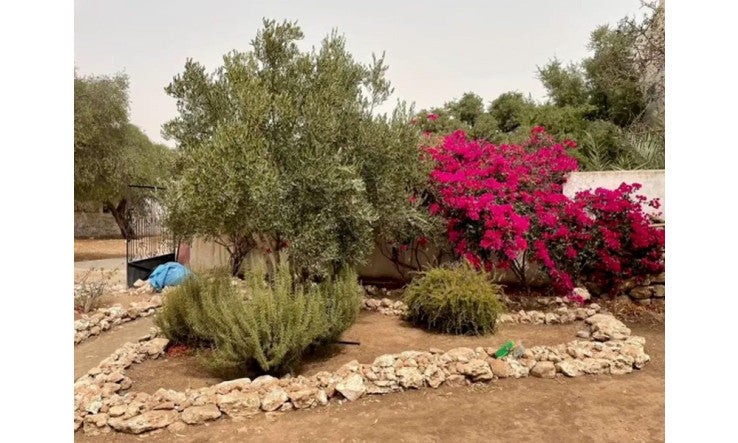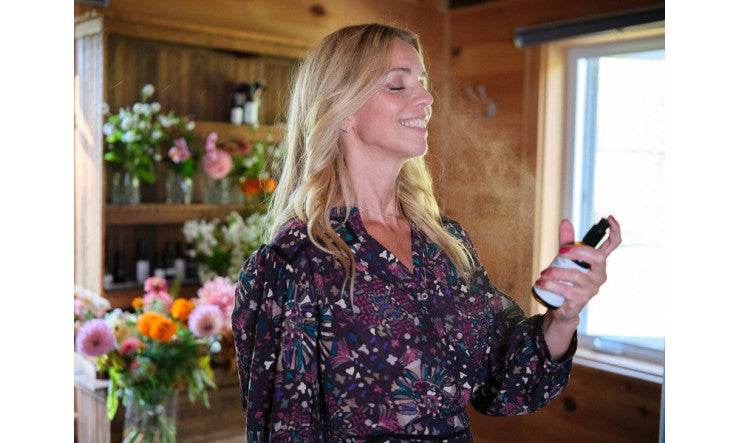Argan tree at the entrance to the cooperative.
Pierre sent our interview to Zahra, manager of the cooperative that produces argan oil:
“ Your support for us is a ray of light in the dark. ”
Live with Pierre Haddad, pharmacologist, scientific researcher, teacher.
3:40 - Can there be side effects with natural health products?
There may be some, but they are usually less severe than with medications. Medications are very powerful and very targeted. However, there are also plants that can be dangerous. This is why Pierre Haddad teaches that medicinal plants, or natural health products, are pharmacologically active. It is therefore important to follow the dosage because, for example, taking more can lead to significant side effects.
5:30 - What does it take to be a research scientist?
First, you need a doctorate. Then, postdoctoral training during which you specialize further and which can last another 2 to 4 years after the doctorate. During this postdoctoral training, we will normally go to another laboratory to learn new techniques, new concepts. It is only after these 2 to 4 years (and sometimes even more) that we prepare and present a research project in order to obtain grants. People wishing to remain in academia can look for an academic position at this time. It is also possible to become a researcher in a company, whether in biotechnology, pharmaceuticals, for the government... There are several possibilities.
* Pierre Haddad adds a nuance: " Sometimes, it is not supported by modern science but it is supported by plant science. "
8:52 – Argan forests
In Morocco, in the Essaouira region, we find argan tree forests, argan groves. Argan trees grow in a semi-arid environment. They play a very important role in protecting against desertification. These trees produce fruit containing a kernel. It is from this kernel that a very high-quality vegetable oil is extracted.
There are two types of oil: cosmetic oil, for which the almonds are not roasted, with a more neutral odor. Food oil, for its part, the almonds are lightly roasted, which gives it a particular odor and flavor.
11:39 – Pierre Haddad’s research on argan oil
With one of his students, Pierre Haddad studied the effect of argan oil on metabolic diseases, particularly those related to obesity and diabetes. It was studied alone, then in comparison with fish oils. It is not quite as powerful as fish oil, but it has a different, interesting profile, particularly in terms of lipid control, as we saw good fats in the body increase (HDL, the famous good cholesterol), bad fats, therefore triglycerides (LDL) and total cholesterol decrease. This has been confirmed by several other studies.
Argan oil is 80% monounsaturated oil, meaning it is a good fat.
1:20 p.m. – Foie gras
Fatty liver isn't just caused by eating fatty foods, but also by eating sugary foods. When we eat too much sugar, the body uses what it needs and stores the rest as fat, which is stored in adipose tissue, which is tissue made to store fat.
Abdominal fat is the most “dangerous” type, associated with significant metabolic disorders.
Although these adipose tissues are designed to store fat, there can be an overflow. That is, the adipose tissues can swell and multiply. Thus, the volume increases either by the size of the cells themselves or by the quantity. This is when an overflow and accumulation can occur, especially in the liver (remember here that the liver is our important metabolic factory).
This is what causes insulin resistance.
The liver is one of the only organs that is able to produce sugar (glucose) when we need it.
The liver can store sugar in the form of glycogen, a form of animal starch. Therefore, we have enough sugar in the liver to survive 24 hours without eating. Thus, the sugar stock, in the form of glycogen, can last us for an entire day.
The liver can store sugar, but it can also produce it from amino acids or fatty acids, which it can convert into sugar, and thus produce sugar. Normally, insulin puts a brake on this production because it is a hormone that tends to calm sugar levels when they rise.
15:30 - How does it work?
The pancreas produces many of our digestive enzymes, but also important hormones like insulin and glucagon, which are like the "yin and yang" for keeping glucose levels balanced. So, after eating, the pancreas reacts. It has "sensors" with which it senses that glucose is rising. So it sends insulin into the system. Insulin acts on receptors, cells (like a key in a lock), and this increases the uptake of glucose by cells, especially in the muscles, which represent a large part of the body's mass.
Normally, insulin puts the brakes on sugar production. However, when the liver becomes engorged with fat, it makes it sluggish and then unresponsive. As a result, it produces too much sugar.
The same thing happens in the muscles, that is, fat also accumulates in the muscles when it overflows. So, there is less glucose entering the muscles because insulin is not working as well as it should, and there is too much glucose being produced by the liver. This is what leads to hyperglycemia, glucose that is high in the blood (when we really have diabetes).
17:20 – Diabetes
Diabetes is a disease that is gradual, progressive and takes several years (between 10 and 20 years) before we unfortunately arrive at complications.
During this time, health professionals will discuss healthy lifestyle habits: increasing physical activity and eating well. These are, in fact, the basics of good health and the prevention of cardiometabolic diseases.
19:10 – The importance of fats
At the time, health professionals suggested cutting out fat when we were struggling with health problems (such as high cholesterol, for example).
Today, things have evolved a lot. We know that it's the quality of fats that's important, not just the quantity. In fact, the much-discussed and widely discussed ketogenic diet is based on significantly reducing carbohydrates and eating lots of protein and good fats, including monounsaturated fats, which are found in argan oil.
19:45 - Does argan oil offer the same benefits as olive oil (as seen in the study cited in the book Longevity)?
Among the important monounsaturates is oleic acid. Olive oil contains about 70% of it. Thus, almost three-quarters of the fat in olive oil is oleic acid.
In argan oil, half of the fats are oleic acid, which isn't so bad!
Argan oil, after olive oil, is one of the vegetable oils richest in oleic acid.
Argan oil also contains linoleic acid which is another monounsaturated.
21:50 - Monounsaturated
In chemistry, monounsaturated means having only one double bond. Fats are like a long carbon strand. There can be double bonds between two carbons, which makes the structure more rigid. Saturated fats are those that lack this double bond, while unsaturated fats are those that have double bonds.
There is a link between saturated/unsaturated fat and the propensity to create atherosclerosis (when fats accumulate in blood vessels). It's not so bad when it's just a small bump, but when the vessel diameter narrows too much, that's when health problems like heart attacks can occur because the blood doesn't flow well to the heart.
This is why a lot of attention is paid to cholesterol, as we try to prevent it. The most dangerous is LDL, the bad cholesterol, because it accumulates in the blood walls and creates inflammation and "clogs" the arteries. Studies show that argan oil helps reduce these LDLs.
24:00 - Argan oil offered at MJ: a little about its history
This is a traditional production that Pierre Haddad and his partner Chantal visited.
A colleague of Pierre, who spent her life studying argan oil, set up cooperatives in Morocco more than 20 years ago to support women and help them in this very demanding production process.
The work was already being done by women, but it was men who held the purse strings...
The crushing is not mechanized. So, they really sit on a cushion, with a small stone on top of a large stone, and crack nut after nut to extract the kernels.
To make 1 liter of argan oil, 32 kilos of these almonds excreted from the nuts are needed! This is approximately 13 hours of work to make 1 liter of oil.
25:30- How much should you consume to benefit from the benefits of argan oil?
Consumption must be regular to achieve the desired effects. Studies were conducted with regular consumption. For example, in these studies, butter was replaced with argan oil in the diet of the study group and compared with the control group that consumed butter. Studies have shown that regular intake of argan oil significantly improves blood fat levels.
26:00 - How soon can we see the difference?
We're talking in terms of months, because it's obviously not done by shouting scissors! So we can think of 3 or 4 months. Studies even talk about 6 months to 1 year. We have to give it time. When we make dietary changes, we shouldn't expect instant results.
26:40 - In the product sheet here , you will find the photos taken by Pierre and his partner Chantal of the community of women who produce the argan oil that we offer at MJ.
28:00 - Foie gras, an epidemic
Fatty liver has unfortunately become the most common liver disease, and this follows the trends in metabolic diseases with obesity and diabetes. Looking at the disease progression maps, we see that it is truly a global epidemic. The World Health Organization considers diabetes and obesity to be global epidemics of non-communicable diseases that can be prevented and even reversed.
We are increasingly talking about the possibility of reversing them, depending on the stage the disease has reached. If it is very advanced, it will obviously be more difficult to reverse.
30:30 – Natural health products, tools
Natural health products are very important tools to help and support the body.
Pierre Haddad also works extensively with Western herbalists. He is also a member of the board of directors of the Quebec Herbalists Guild. He has long been interested in this field!
At the time, he conducted a survey in Morocco to identify the most recommended plants for diabetes. There was, of course, the famous argan oil, but also black seed oil, which is found in Metabzen and Gluconig products.
Upon his return to Quebec, he conducted the same survey with herbalists here and it was then that he identified the blueberry, on which he also worked extensively. This was not at the level of the fruit itself but at the levels of the roots, leaves and stems, the latter of which were previously considered as waste but which also demonstrated interesting effects in the same way as the rest of the plant. It is a beautiful secret that is unfortunately little known.
33:00 - If we take Omega-3, can we also take argan oil?
There is no problem, it complements each other well.
35:35 - Argan oil is a great oil to add to the beautiful palette of oils we already have like olive oil, avocado oil, and coconut oil, depending on individual tastes.
36:30 - Sharing fabulous testimonials about Metabzen and Gluconig, the goal being to help people.
38:30 - Nature is here to help us!
Modern pharmacopoeia owes a great deal to traditional pharmacopoeia. Many medicines are derived from, developed for, and derived from natural substances that have been used traditionally. This is an often overlooked fact, but it is estimated that 40 to 60% of medicines are derived from plants and other uses that come from nature.
41:00 – Metabzen & Gluconig
Metabzen : for cardiometabolic well-being; to improve liver function and also help better control blood glucose.
Take one capsule 1 to 2 times a day, at a time of your choosing, but at least 2 hours apart from taking your medication.
Gluconig : Contains a blend of brown algae, developed by a Quebec company, combined with Nigella. Supported by a wealth of scientific data, the brown algae it contains reduces the impact of sugars by slowing their digestion, so we absorb less. Combined with Nigella, which helps insulin work better. A great, more specific combination to take before the two most important meals of the day.
Disclaimer: The summary of the interview with Pierre Haddad was created solely for the purpose of allowing you to easily find the information you are looking for. Under no circumstances can the information you find here be considered personalized medical advice. In addition, we invite you to listen to the video for complete and accurate information on the topic discussed and, of course, to consult your healthcare professional.


































































Leave a comment